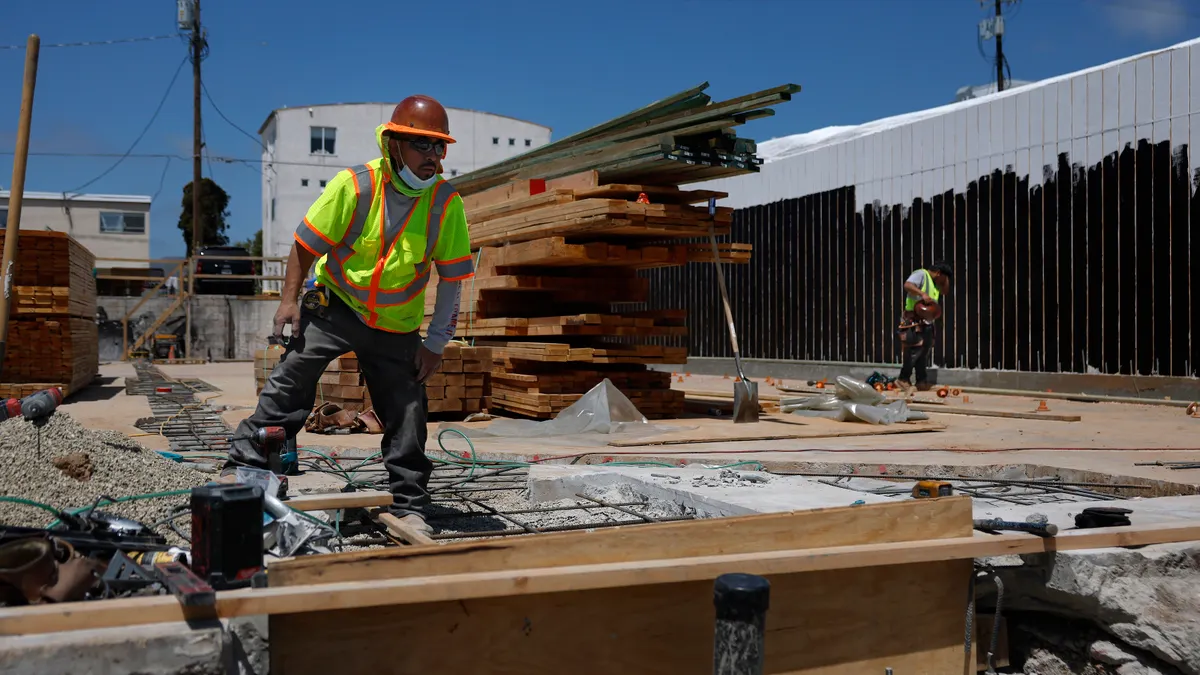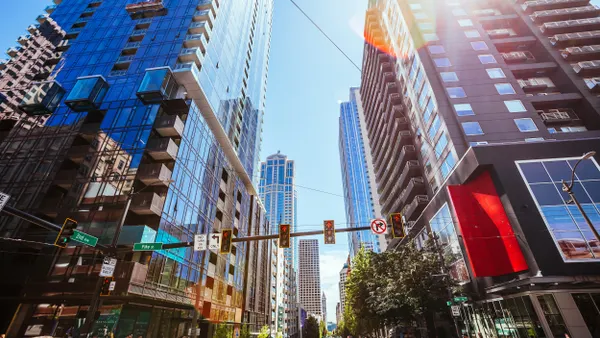Imagine a world where city residents can walk up to fixed infrastructure — such as lamp posts, bus stops or statues — and strike up a conversation via text message or Facebook Messenger.
That’s the aim of Hello Lamp Post, a United Kingdom-based company that invites people to engage in conversations with the objects around them. Those objects can then provide information on wayfinding, culture or tourism — or provide a way for people to give feedback on city initiatives and plans.
Having already launched in 16 cities worldwide, including Austin, TX, the company plans to further expand in North America and Europe.
Smart Cities Dive caught up with Hello Lamp Post’s CEO Tiernan Mines to discuss the company’s technology, its plans for expansion and how it seeks to bring residents closer to their cities and infrastructure in what Mines described as a more "playful" method.
This interview has been edited for brevity and clarity.
SMART CITIES DIVE: What’s the thinking here?
TIERNAN MINES: I often like to use the analogy that if you think of a city as a product or a service, in no other realm would you design that product or service without considering the end user. You would never design the iPhone without taking into account the end-user, whereas cities have done exactly that. Historically, they've never taken into account the citizen and what their needs and wants are, and that's where we're trying to bridge the gap, between city and citizen, and allowing that playful, humanistic conversation to continually happen so that feedback loop is closed between city and citizen.
And on the citizens' side, they have more of a voice over the decisions that are being made about their communities, and on the city side they better understand the citizens' needs and wants, so they can make better decisions.
Where have you deployed, and why?
MINES: We've deployed in 16 different cities around the world, from Singapore to Austin, TX, to Malmo, Sweden, to London, to Tokyo, for a variety of different reasons. That links to what people tend to chat about and what cities want to engage citizens on, and it can really vary from cultural points of interest and bringing those historical stories to life through to discussing issues around transport or public consultation about changes in the urban environment or smart city technology initiatives that are being implemented. It's all driven by the fact that I think it's going to become increasingly important to continually engage citizens with the statistic bearing down on us that around 70% of the world's population by 2050 will live in cities. That issue of including citizens in decisions is going to become even more important, especially with this whole realm around more technology coming in to smart cities.
We launched in Belfast two weeks ago, trying to bring the cultural stories along their Maritime Mile to life for visitors and citizens. We are launching in Vancouver in about four or five weeks across the University of British Columbia campus, which is around engaging students and citizens on changes happening to the environment as well as using infrastructure to better prepare them in case of a natural disaster. It's all around an education piece and an engagement piece so they're better prepared if and when a natural disaster happens and they're on campus. There's a couple of cases in London, working with the councils around public consultation on changes to the urban environment.
What does it look like from the user’s end?
MINES: They would see some sort of signage that we've put in place, which might say, "Objects are waking up in this area to talk to you about X," or there might be a sign next to a lamp post or bus stop that says, "Hey, I'm a talking bus stop, chat to me by texting this number, 'Hello bus stop.'" Either there'll be a set phone number if it's over SMS for that deployment or that area, or it'll be a Facebook Messenger account they need to message, or just a link. They don't have to download an app, so there's not that barrier to entry. There's no hardware that needs to be installed.
We basically overlay our platform onto existing infrastructure and we use pre-existing codes that already exist. All bus stops and lamp posts are numbered anyway, we just utilize that numbering, or what we can do is pre-map certain objects so if it's statues or cultural points of interest we can pre-map those objects onto the system so that when someone sees a sign, or in the future they just know Hello Lamp Post exists. That's our vision: they know they can interact with their city using Hello Lamp Post at any point at any location, and they can chat to it about whatever. That's the vision, but at the moment it's a call to action sign essentially.
"We have a strong belief that every single city around the world has one if not hundreds of uses for Hello Lamp Post, and engaging citizens in general."

Tiernan Mines
CEO, Hello Lamp Post
What could they talk about, and how do you foresee that evolving?
MINES: At the moment, a lot of the deployments are driven by certain themes, purely because of user experience. We find the user experience at the moment is better if it's themed. So if it's around community engagement, let's say, around Malmo around sustainability. We're working with the city around their United Nations-set sustainability goals, so there's a theme there. It's always related to the user. There's the education piece about what sustainability means, what the goals are, what initiatives are planned in that city, but also finding out what they think, what their ideas and opinions are, with an open-ended element to it.
They can ask the system questions, they can meander off slightly in the experience, but the system will always slightly nudge back towards that theme at the moment. The future vision is that you could wake up a lamp post and ask to talk about the transport in the area or tell it you're traveling across London and ask about the air quality and the delays on the London Underground. We're already starting to build in things like live data API about train delays and the weather at the moment, things like that, which goes straight into the conversation seamlessly.
The plan is: Imagine you step off a plane and you know Hello Lamp Post exists. If I land in Washington, DC, the system knows I have never spoken to Hello Lamp Post in Washington, so it can make assumptions and imagine I'm a tourist so maybe start talking about tourist information. If he then directs the conversation towards the air quality, it will start responding and answering questions around that. That's the grander vision: you know Hello Lamp Post exists in a city, and you can talk to it about anything and it'll be a friendly conversation.
What other expansion plans do you have?
MINES: We have a strong belief that every single city around the world has one if not hundreds of uses for Hello Lamp Post, and engaging citizens in general. That is our plan: to be in every city in the world. I guess more medium-term, in terms of cultural similarities, governmental structures, city infrastructures, North America and Europe are of particular interest to us. We've done two projects in the US, in Arizona and Texas, and then Vancouver launching. What we've found from those projects is exactly those three points, so that is certainly a focus. We're waiting on confirmation, but we're hopefully going to be launching in another East Coast Canadian city in the next few months.
Definitely, North America is a focus for us. A difficulty for us from London is not being there on the ground, so we're slowly making inroads with a lot of smart city consultancies and getting close to city governments out there. We definitely see some power in it in terms of being able to make comparisons across US cities, and that is the first question we get from US cities — what can you show us from the other cities?


















